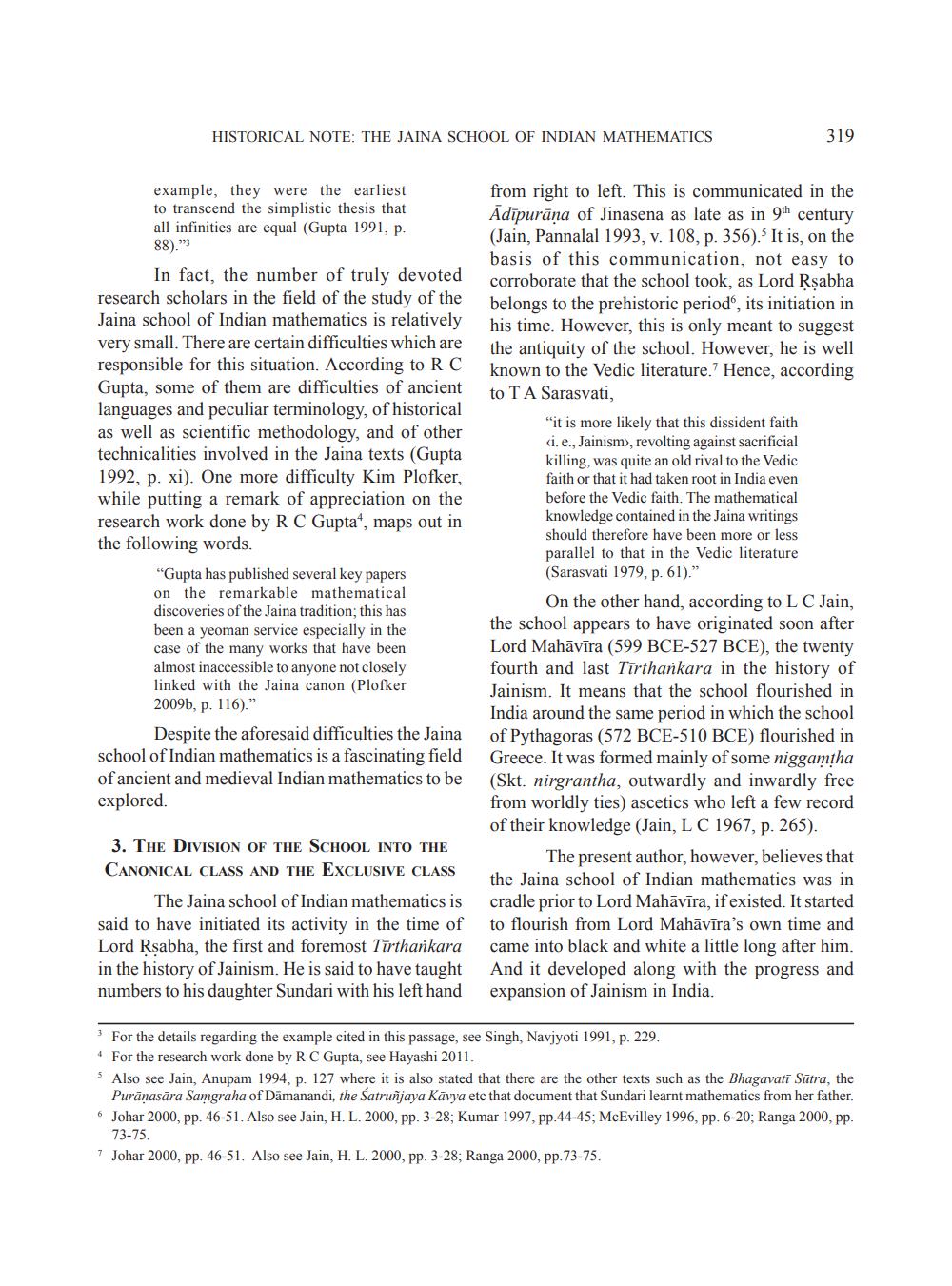Book Title: Jaina School Of Indian Mathematics Author(s): Dipak Jadhav Publisher: Indian Journal of History of Science View full book textPage 4
________________ HISTORICAL NOTE: THE JAINA SCHOOL OF INDIAN MATHEMATICS 319 from right to left. This is communicated in the Adipuräna of Jinasena as late as in 9th century (Jain, Pannalal 1993, v. 108, p. 356). It is, on the basis of this communication, not easy to corroborate that the school took, as Lord Rsabha belongs to the prehistoric period its initiation in his time. However, this is only meant to suggest the antiquity of the school. However, he is well known to the Vedic literature. Hence, according to TA Sarasvati example, they were the earliest to transcend the simplistic thesis that all infinities are equal (Gupta 1991, p. 88)." In fact, the number of truly devoted research scholars in the field of the study of the Jaina school of Indian mathematics is relatively very small. There are certain difficulties which are responsible for this situation. According to RC Gupta, some of them are difficulties of ancient languages and peculiar terminology, of historical as well as scientific methodology, and of other technicalities involved in the Jaina texts (Gupta 1992, p. xi). One more difficulty Kim Plofker, while putting a remark of appreciation on the research work done by RC Gupta, maps out in the following words. "Gupta has published several key papers on the remarkable mathematical discoveries of the Jaina tradition, this has been a yeoman service especially in the case of the many works that have been almost inaccessible to anyone not closely linked with the Jaina canon (Plofker 2009b, p. 116)." Despite the aforesaid difficulties the Jaina school of Indian mathematics is a fascinating field of ancient and medieval Indian mathematics to be explored. "it is more likely that this dissident faith Ki.e., Jainism, revolting against sacrificial killing, was quite an old rival to the Vedic faith or that it had taken root in India even before the Vedic faith. The mathematical knowledge contained in the Jaina writings should therefore have been more or less parallel to that in the Vedic literature (Sarasvati 1979, p. 61)." On the other hand, according to L C Jain, the school appears to have originated soon after Lord Mahāvīra (599 BCE-527 BCE), the twenty fourth and last Tirtharkara in the history of Jainism. It means that the school flourished in India around the same period in which the school of Pythagoras (572 BCE-510 BCE) flourished in Greece. It was formed mainly of some niggamtha (Skt. nirgrantha, outwardly and inwardly free from worldly ties) ascetics who left a few record of their knowledge (Jain, LC 1967, p. 265). The present author, however, believes that the Jaina school of Indian mathematics was in cradle prior to Lord Mahāvīra, if existed. It started to flourish from Lord Mahāvīra's own time and came into black and white a little long after him. And it developed along with the progress and expansion of Jainism in India. 3. THE DIVISION OF THE SCHOOL INTO THE CANONICAL CLASS AND THE EXCLUSIVE CLASS The Jaina school of Indian mathematics is said to have initiated its activity in the time of Lord Rsabha, the first and foremost Tirtharkara in the history of Jainism. He is said to have taught numbers to his daughter Sundari with his left hand * For the details regarding the example cited in this passage, see Singh, Navjyoti 1991, p. 229. 4 For the research work done by RC Gupta, see Hayashi 2011. 5 Also see Jain, Anupam 1994, p. 127 where it is also stated that there are the other texts such as the Bhagavati Sūtra, the Purānasāra Samgraha of Damanandi, the Satrunjaya Kāvya etc that document that Sundari learnt mathematics from her father. 6 Johar 2000, pp. 46-51. Also see Jain, H. L. 2000, pp. 3-28; Kumar 1997, pp.44-45; McEvilley 1996, pp. 6-20; Ranga 2000, pp. 73-75. 7 Johar 2000, pp. 46-51. Also see Jain, H. L. 2000, pp. 3-28; Ranga 2000, pp. 73-75.Page Navigation
1 2 3 4 5 6 7 8 9 10 11 12 13 14 15 16 17 18 19
